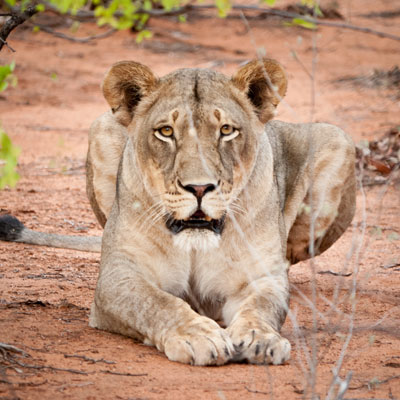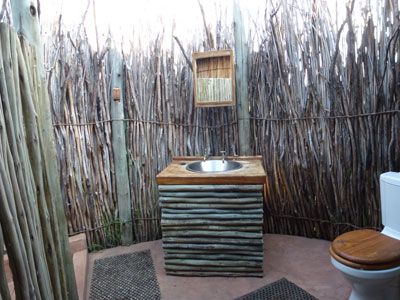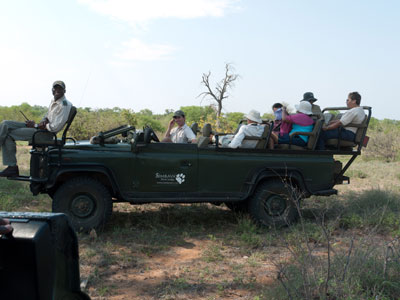Spending 20 fantastic days in Southern Africa
This article appears on page 46 of the February 2013 issue.
by George Anderson; Minneapolis, MN
In 2009 my wife, Sandra, and I traveled through the Cape Town area with Pierre Duval of BushBaby Safaris (KwaZulu-Natal, South Africa; phone +27 [0] 34 212 3216), a family operation that offers only custom tours. Pierre’s wife, Karen, and one staffer handle the logistics, while Pierre and a few Pierre-trained people do the guiding. On that trip, the joke became that we had to “come back to see the real Africa.”
In the winter of 2010/11, we e-mailed BushBaby Safaris and asked, “When should we come?,” “Where should we go?” and “How long should we stay?”
After a lot of back-and-forth discussion, the answers were “October/November,” “South Africa, Zimbabwe and Namibia” and “Three weeks.” So in November 2011, that’s what we did.
Four countries
After a couple of tourist stops in the Johannesburg area, we started our trip on the west side of Greater Kruger Park in the Timbavati, one of a number of areas of privately owned and public lands (including lands in Zimbabwe, Botswana and Mozambique) that together comprise over 10,000 square miles of unfenced natural habitat.
From there, we visited a second park in South Africa, then traveled to two parks in Zimbabwe, continued on to Victoria Falls and, finally, stopped at game parks and the Etosha Pan in Namibia.
What struck us throughout the trip was that, while there were many impoverished people in the countries we visited, the road systems were good, the hospitality was great and we always felt safe.
The biggest problem with traveling on the roads was having to watch for herds of wild and domesticated animals, which seemed drawn to the hard asphalt surface.
When Karen and Pierre proposed including Zimbabwe in our itinerary, we raised our eyebrows a bit. This country has been financially ruined by its dictator, turning it from a breadbasket for Africa into a net food importer and suffering through a lengthy period of hyperinflation.
Not to worry, Pierre and Karen told us. Zimbabwe is now using the US dollar and the South African rand (among others) for currency, and prices are stable.
Pierre, who was born in the capital city of Harare, had made an exploratory trip to Zimbabwe in the spring of 2011 and pronounced the country ready for visitors. He was right. We had a great time.
The lure in Namibia was the Etosha Pan, a 75-mile-long dry lakebed surrounded by excellent habitat and protected as part of Etosha National Park.
The camps
Most of our accommodations were in “tented camps.” If this brings to mind Boy Scouts, mosquitoes and pit toilets, you couldn’t be more wrong! Each camp had a luxurious main lodge, usually made of native stone and beautiful hardwoods and including a reception area, lounge space and dining room. Surrounding this were usually around a dozen separated guest quarters.
The majority of our quarters could be called “tents” only because they had canvas walls and ceilings. Each was raised on a wooden platform and included a large, luxurious bathroom, a main room with one or two double beds, and a large front porch with a table and a few chairs.
The main room was usually air-conditioned, the temperature and fan speed controlled by a handy remote. In a few cases the shower was outside, surrounded by a privacy screen and open to the sky.
Here’s a recap of some of the properties.
The Simbavati River Lodge in Timbavati was a beautiful property with game visible from the dining room and lounge. The meals, served buffet style, were very good.
The outdoor shower in our “tent” was open to allow views of the river, but it was very private.
If you must go only one place for game viewing, this is the place. It was there that we saw white lions and made our first sweep of the Big Five.
We would give Simbavati the award for Best Game Variety and Viewing.
Having seen all of the Big Five (lion, leopard, elephant, Cape buffalo and rhino) at Timbavati in one morning, we told Pierre that we could save a lot of money and go home now; we had seen everything! He just laughed and said he had a few more things to show us. As it turned out, he did.
Located in South Africa’s Mapungubwe National Park, Mopane Bush Lodge was another beautiful property. Dinner was served on linen-covered tables on the front lawn the first night and in the large outdoor patio on the second. The food and hospitality were excellent.
The property manager, Andrew Rae, personally guided us to see San rock art thousands of years old. Mopane also has a special arrangement with a game reserve owned by De Beers Consolidated Mines, where we radio-tracked lions, resulting in our getting some very nice pictures.
Guest quarters were luxurious stone buildings with patios overlooking a large valley.
Award — Best Host.
In Zimbabwe, we overnighted at Big Cave Camp, the most spectacular property we’ve stayed at anywhere in the world.
In the car park at the bottom of the hill, there’s a sign that says “Visitors Please Hoot.” Hooting (beeping the car horn) called forth a Land Rover, driving in low gear down the steep rock face from the lodge above. Our bags were transferred, and we jumped into the Landy and ground back up the rock at what felt like a 45-degree climb. The lodge, the separate dining/kitchen area and the guest quarters all were built into the rock hill and constructed of beautiful stone.
Service was especially attentive, as we were the only guests.
This is a property worth a detour, even if you don’t have time for a game drive.
It was on the Big Cave morning game drive in Matobo National Park that we saw the bones and bullet-marked skull of a poached rhino and first heard the story of their likely extinction.
Award — Most Spectacular Property.
Zimbabwe’s Sikumi Tree Lodge was probably the most fun, even though the power was out due to storm damage.
There was a water hole directly in front of the main lodge and lounge area, no farther than 50 yards away, and as we drove into the property, a huge herd of buffalo was milling around. Within a few minutes, that herd moved out and an equally large herd of elephants arrived, with the “children” gaily jumping into the water hole and splashing. Later, a large family of baboons took over.
The food and lodging (wood cabins raised on stilts) were very good, and the staff was very hospitable despite struggling to cook and serve with no electricity.
We liked Sikumi so much that we tried to extend our stay for a day; unfortunately, there were no vacancies.
Award — Largest Quantities of Game.
Also in Zimbabwe, A’Zambizi River Lodge is the only Victoria Falls hotel located right on the river. This 83-room tourist hotel was well appointed and clean but boring, in that there are hundreds like it all over the world. Dinner was a somewhat disappointing buffet, but sitting at our table watching the resident warthog family trim the grass in the yard was kind of fun.
If you’ll be staying somewhere near Victoria Falls, this is probably your best choice.
Namibia’s Camp Kwando was, to paraphrase Dickens, “the best of times and the worst of times.” The lodge, itself, was beautiful, and the food was the best of the trip. Our lodging, however, was in a primitive tent (though on a platform and with a patio), with an outside bathroom and shower open to the sky. There was no heat or air-conditioning and only part-time electricity.
So, of course, our day at Camp Kwando was our only day of cool, rainy weather. Trust me, the charm of an open-air bath and shower is substantially diminished when you are out there in a cool, steady rain.
The minimal charm of the tent was further reduced by our cold, wet clothes hanging everywhere. Schedule good weather if you plan to visit Camp Kwando!
Awards — Best Food and Worst Room Lighting.
We have to give Namibia’s Okonjima Lodge the Best Accommodations award. The lodge and guest chalets were large and luxurious, the food was excellent, and radio-tracking both leopards and cheetahs there was great fun.
Warning — don’t judge any of these properties by their websites. Some have found talented, motivated Web designers; some have not. All were great places to stay, each with its own little treats and, occasionally, warts.
Game viewing
Game park guests typically take morning and evening game drives in open vehicles, often with a “tracker” perched on a seat at the front and a large-caliber rifle in a rack welded to the dashboard.
Many of the animals are acclimated to seeing the vehicles and are completely unbothered by them. We were told that they see the vehicle (and its tasty contents) as a single large object that has (a) never threatened them, (b) never given them food and (c) never stolen their food. Hence, it is ignored.
Every safety briefing, however, includes the warning “Never stand up or put part of your body outside the vehicle,” as this “breaks the outline” of the single large object that the animals see. I have no idea why this admonition does not apply to the trackers.
We saw lots of lions, mainly females and cubs. Lions sleep 18 to 20 hours per day, so that’s mostly what we saw them doing.
A major highlight of the trip, though, was seeing two rare white lions. These were yearling females with very, very light tan fur and blue eyes — not albinos but the result of a gene mutation. Amazing. Our best lion viewing was in Timbavati and Etosha.
According to Pierre, the leopard is the animal of the Big Five that many people miss seeing. In Timbavati, our first stop, we saw leopards on two game drives. When we radio-tracked leopards at Okonjima, home of the Africat Foundation, one leopard calmly walked within a few feet of our vehicle. When he finally tired of our gawking, he went off to sleep in a tree.
We did not see cheetahs until we got to Etosha, where we saw a mother with two cubs.
Elephants were everywhere. It was spring in the Southern Hemisphere, so there were baby elephants to see and photograph.
Cape buffalo also were ubiquitous. These, and hippos, are considered to be the two most dangerous animals of those we encountered because they will attack without warning. Most animals, like elephants and lions, have warning behaviors, like false charges, but when a buffalo or hippo decides he’s after you, he’s after you!
Rhinos were a little less common. On the first morning in Timbavati, we saw a very shy white rhino in the bush, but he wouldn’t hold still for pictures or gawking. Later, in Zimbabwe’s Matobo Park, we were able to walk within about 25 yards of a white rhino, and we saw a very nice black rhino in Etosha.
Incidentally, “white” rhinos aren’t white. The word is thought to derive from the Dutch word “wijd,” meaning “wide,” which describes the animal’s lower jaw. White rhinos have wide lower jaws and black rhinos have narrower jaws, but the two are about the same color.
We heard the sad story of impending rhino extinction several times. We were told that a good rhino horn has a street value of a quarter-million dollars in Asia, where it is thought to be a sexual stimulant. An African who might be living on a dollar or two a day can sell a horn for $1,000. This drives poaching, and many conservation organizations fear extinction will be the final result. If you want to see rhinos, go soon.
Baboons to bugs
There isn’t enough space to list all the other animals we saw. Graceful giraffes were common and a lot of fun to see running. Watching them drink, with front legs spread wide so they could reach the water, was interesting, too.
We saw many baboons from a distance. None wanted to pose, though, so our photos are mostly of baboon butts heading for the bush.
Jackals, we decided, have a bad rap. Not sinister at all, they’re just cute and curious little fox-like animals. We did have an encounter with a spotted hyena (thought later to be rabid), which attacked the hood of our car while we were inside.
And the number of different types of antelope was amazing! To say we saw thousands of antelope is no exaggeration.
We saw so many plains zebras that after a while we didn’t even slow down to look. We also saw a few of the rarer mountain zebras.
What about bugs? There were no bugs to speak of anywhere. Some of the destinations had been designated malaria areas by the World Health Organization, so we had our Malarone, but I really don’t think it was necessary.
Pierre is a birder. I think we were given the proper names for at least a hundred birds. He even used his iPhone to play their calls for us. The funniest birds were the guinea fowl, which ran around the bush in large flocks and, in unison, sang a very distinctive chorus.
The details
It was a great trip. Our total cost was about $15,000, excluding airfare.
We had an interesting discussion about cost with Pierre. He and Karen also organize self-drive tours for customers. He estimated that our having him as a private guide and driver cost us about 10% more than a self-drive tour would have cost. This is because renting a vehicle is so expensive and because of the discounts that BushBaby is typically able to get. (At most properties, the guide stays and eats at no charge.)
He estimated that for a party of four, having a private guide and vehicle would actually save them about 20% compared to taking a self-drive tour.
It’s probably obvious by now, but we wholeheartedly recommend Karen and Pierre Duval for planning a trip anywhere in Southern Africa. As Meredith Willson wrote in “The Music Man,” “You gotta know the territory.” They do!





